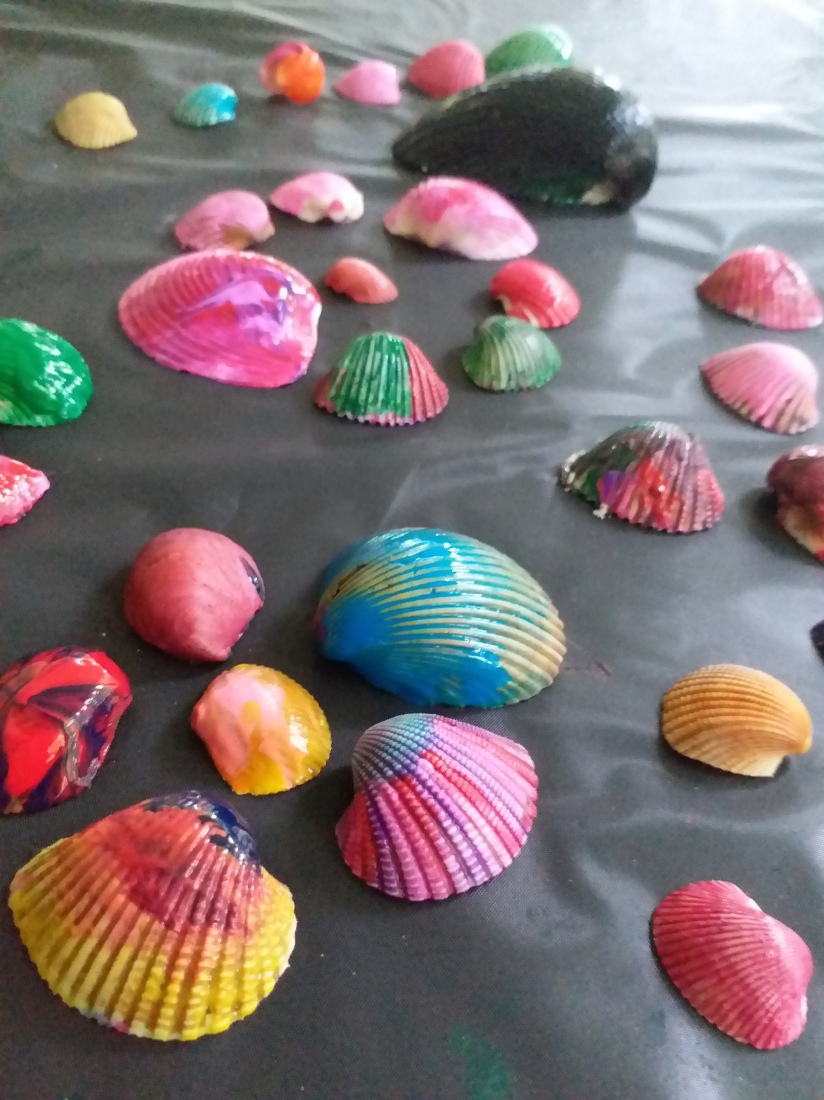I have a bit of an obsession with mobiles. Windchimes, hanging plants, hammock chairs, dangly earrings. Anything that anchors from above is kinda my aesthetic. So when my kids were collecting a TON of shells at the beach, I only encouraged it as I had a vision! A rainbow seashell mobile is on my mind!
This emotional intelligence activity is step one!
Encourage Exploration
When doing a new organized activity with kids, especially younger ones. It’s a good idea to let them first explore with the materials first. Curiosity can be hard to direct in children. If you’re doing a science demo, that really helps with steering their attention. Otherwise, it’s easier to let their curiosity run its course and do the activity when it’s been sated. This exploration time doubles as extra prep time!
Emotion Token Prep
After getting the kids some paints and shells to start exploring with, I grabbed a handful of shells to get started. Using a fine tip permanent marker, I drew faces expressing different emotions on my shells.

I bought this Expression Drawing Reference resource for one of my art camps and it’s a great help for doodling emotions! I did these off the cuff and looking back over the resource, I wish I had jogged my memory first! I’m uncertain about how I feel about my uncertain token…
You’ll want to cover the basic emotion spectrum. Happy, sad, angry, afraid, disgusted. That’s right, the Inside Out characters! Those are broad categories and so you don’t need to feel confined to those 5 or obligated to them. Here, I have happy and I also have silly and excited. I don’t have afraid, but I do have surprised and stressed. The 5 basic categories are just to help us not to forget any major ones. You may also want to include emotions your kids are currently dealing with. The next step, though, will be letting them decide what emotions they see. So you don’t need to get too bogged down in the perfect recreation of “perplexed” and you don’t need to have just the right word for the expression you’re drawing!
Using Emotion Tokens for Emotional Intelligence
While the kids are still engaged with the paint and shells, but have calmed down after that initial wave of excitement over new activities, you have your golden window for this activity.
Questions
- What emotion do you see here?
- Can you make that face?
- When was a time you felt ___________?
- What colors does _________ look like?
- Can you paint the shell that color?
- When were times that you felt _____________?
The brain can be triggered by muscle memory. It knows that you smile when you’re happy. So if you’re smiling, it assumes that you must be happy and releases dopamine and serotonin. A study on Botox patients discovered being literally unable to frown, resulted in happier patients! (I didn’t read the study and I do wonder if they were just happier because their wrinkles were gone…)

But even when the brain isn’t releasing chemicals, the muscle memory is powerful. Forced expressions can manufacture at least shadows of actual feelings. So by asking kids to mimic the expression, we’re inviting them to feel those emotions. The next question of “when did you feel that way” cashes in on the muscle memory. Their face is already contorted in anger, when were their muscles doing that before. Recalling an event helps us dive deeper into that emotion, as kids empathize with themselves within the memory.
When we introduce the color, we’re inviting self-exploration, awareness, and control. Not everyone chooses yellow for happiness. Some people hate yellow. To be stuck using yellow to indicate happiness when you hate yellow invokes the opposite of happiness! So let them decide for themselves their feelings palette. They may choose a more traditional color or they may choose something that’s a bit more personalized. Knowing your colors does give you a bit of influence in your environment and over your mood!
As they’re working on painting the shell, this can often be a good time for reflection. I find many kids just start talking when they’re painting, but if they need a prompt, asking them what other memories they have of that feeling can invite them to process those, too. Just remember, this should be a safe place for processing where they receive empathy and not dismissal, disapproval, or fixing.


Developmental Stages
Younger children don’t often like to think about high needs emotions. They probably won’t want to make a sad face, because making a sad face makes you feel a little sad and sadness can be heavy. That’s ok. You can say, “you don’t want to make a sad face. Making a sad face makes you feel sad and you don’t want to feel sad right now.” This helps them be a bit more self aware, as it validates their position. They may still be willing to pick out colors and maybe even talk about sad events. Young children also have a tendency to project their feelings onto other things. It gives them a bit more distance between themselves and the emotion, so don’t feel discouraged if they start talking about a dinosaur that fell down a well when you were aiming for a personal anecdote.












Nice therapy